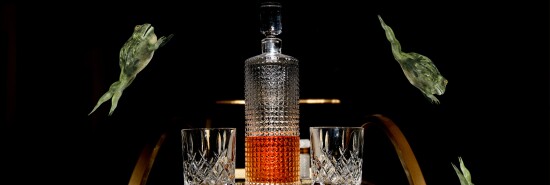
The American language of drinkin’
Eric Felten
American speech, committed to paper, has long made for a good laugh. The nation’s preeminent writer of comic fiction had a knack for capturing on the page the sound of Americans talking. Consider this perfect piece of description, perfection found not in the description of the cow but in the nonstandard language used to describe the creature: “Well, thish-yer Smiley had a yeller one-eyed cow that didn’t have no tail, only jest a short stump like a bannanner.” We have been alerted, by the yeller, not “yellow,” cow who had not a tail but jest a short stump like a bannanner — alerted that we are in for some silliness, for some ridiculous (or should that be er‘diclus) doin’s, alerted in this case by no less than Samuel Clemens himself.
This delightful nonsense is found in a bit of tall-tale foolishness by Mark Twain, the “Celebrated Jumping Frog of Calaveras County.” Somehow, the story has survived without becoming the target of the professional complaining class. One can simply call it a story rather than having to label it controversial. Nor even contraversh’l. This, even though there is clear abuse of a bullfrog involved in the story’s gag.
Authors don’t much like using “dialect” anymore. The writer runs too much risk. Then again, perhaps dialect declined in fiction simply because readers tired of making sense of phonetically rendered nonstandard English.
It may be too late to do anything about the loss of dialectical detail, which is something of a shame. Late in the 19th century, there was still a taste for dialect, usually to identify who was from Hicksville, uneducated, or both. Sometimes, dialect was used to contrast a likable, colorful character with the stuffy sort of city folk who don’t drop their Gs.
Comic dialect can also tell us a lot about social mores and fashionable tastes. For example, as early as the 1860s, there are plentiful references to “fancy drinks,” so much so that you would think American drinkers were lining up from sea to shining sea to get cobblers and fixes and fizzes and every sort of alcoholic confection dressed in mint and other garlands and garnishes. But recently, I ran across a tale from 1899. Told in dialect, the vignette suggests the taste for fancy drinks was primarily a metropolitan one.
The story starts with Bill, a veteran of the Rough Riders, recently of San Juan Hill-charging fame, returning home to the fictional bumpkinville town of Red Dog, Arizona. After much whoopin’ and hollerin’, some questions and greetin’s are heard. “Glad to see yer back, Bill,” and, “Thort youu’d git killed sure.” Another voice called out from the crowd, “Must o’ hed a tough time of it down there.”
“Tough time?” Bill replied. “Well, I should say it wuz.” The battle was worse than a stampede and a cyclone “rolled into one.” The admiring crowd demands to hear the details. “I dunno ez I kin, boys,” says Bill. “Yer wee it wuz all mixed up like, an’ I cain’t git ther fac’s straight in my head.”
“There was yellin’ and hoorayin’ an’ shovin’ an pullin’ this way an’ that, an’ slappin’ a feller on the back an’ buyin’ drinks.”
“Oh, Lord, it wuz awful,” says Bill. “The people down there don’t drink whiskey straight like we does. They mixes up a lot o’ dope with it an’ calls it a cocktail er a rickey er a fizz er the Lord knows what all.”
A-feared that he was about to be drowned in doctored liquor, he shot his way out.
“Where did all this happen?” shouted someone in the crowd. “Why, in Noo York, of course.” The scrap in Cuba was nothing compared with the danger of getting crushed in the big city. “I’d ruther go through twenty scraps like that then to stay in Noo York another week.”
CLICK HERE TO READ MORE FROM THE WASHINGTON EXAMINER
Eric Felten is the James Beard Award-winning author of How’s Your Drink?
